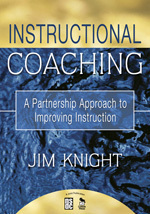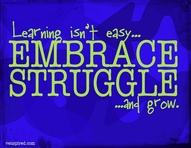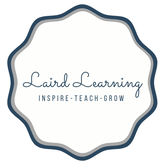 Recently, a fellow elementary Instructional Coach suggested we do a book study over Jim Knight's Instructional Coaching: A Partnership Approach to Improving Instruction. Not being one to turn down the opportunity to read a great book or learn something new, I jumped at the opportunity and spent the weekend reading the first chapter. The biggest takeaway I had from Chapter 1, revolves around the idea of Professional Development, and the ineffectiveness of traditional forms of professional development. Knight says traditional professional development involving a speaker, typically an outsider or stranger, lacks follow-up and doesn't take teacher expertise into account. I have led and attended these type of PD sessions, and agree with Knight, that little change occurs because of these sessions. So what can be done? Will teachers continue experiencing ineffective "one shot" PD sessions? How can I keep my colleagues, PLN, and conference attendees from experiencing the same frustration and the "this too shall pass" feeling? These were a few questions bouncing around in my head as I continued reading. Jim Knight proceeded to explain that Instructional Coaching, a method to help teachers learn better ways to teach their students, is one efficient model. While Instructional Coaching will impact teachers in my elementary building, as I work in one-on-one partnerships with them to reach goals they set, I can't help but think about our weekly building level professional development sessions. While they are tailored to our staff, they too can be viewed as "one shot" PD. Throughout chapter one I was reminded of the impact my position as an Instructional Coach can have on teaching and learning at our building, but I don't feel as if I have scratched the surface when it comes to effective Professional Development outside the one-on-one partnership between a teacher and Instructional Coach. I believe I need to continue searching for ideas, like Personalized PD and TeachMeets, and develop ways to incorporate teacher expertise and interests into our building level PD. On a larger scale, I need to reflect upon the type of presentations I do at conferences and institutes, incorporate follow up conversations, and above all remember Knight's comment "Teachers engage in professional development all the time, they just don't do it with professional developers" (pg 3). How do you see Professional Development changing? Do you feel "one shot" PD sessions should be done away with? What ideas could you have to share regarding effective PD strategies you've utilized or experienced?
0 Comments
On Tuesday, I had the opportunity to model an ELA lesson in fifth grade. The class has been reading biographies, and the teacher wanted them to work on sequencing the historical figure's life events using a timeline. Rather than simply going in and teaching the students how to make a timeline, I decided to use a modified version of the Gradual Release Model. Below you will find the lesson information. If you aren't familiar with ReadWriteThink's Timeline Generator, I highly recommend you check it out. The Timeline Generator is one of over fifty-nine student interactives ReadWriteThink provides free of charge.
Learning Target: I can create a timeline to sequence events. Technology Tools Used: ReadWriteThink's Timeline Generator, Mr. Nussbaum's Biographies I do: Helen Keller Walk through creating a timeline using Helen Keller's life. 1880 Born in Tuscumbia, Alabama 1881 Blind and deaf from high fever 1890 Knew manual alphabet, Braille, and how to use the typewriter 1904 Graduated from Radcliffe College 1964 Presented with Medal of Freedom 1965 Elected to Women’s Hall of Fame 1968 Died We do: Derek Jeter Read the passage as a class, then together create a timeline of Derek Jeter's life/career. 1974 Born in Peqannock, New Jersey 1991 Played Minor League Baseball 1995 Made it to the Majors 1996 Rookie of the Year 2012 Career Batting Average .313 You do: Lou Gherig Students were to read Lou Gherig's biography, and then create a timeline of his life. I created a Padlet for students to share their finished timelines. Due to time, the classroom teacher decided to have students not complete this part, and instead create a timeline based on a historical figure they read about last week.  Today I had the opportunity to attend Heartland AEA's Instructional Coaching Network. One of the facilitators had us share our "Sparkle" or positive moments that have happened in our coaching role this year. She stressed the importance of identifying three positive things that happen each day. I've decided to take her suggestion to heart and spend a few minutes at the each school day reflecting on the day's "Sparkle" moments. Doing this will allow me to end the day on a good note, while keeping from becoming bogged down by challenges that come with being a first year Instructional Coach. Three positive events of the day:
What were your "Sparkle" moments? Yesterday our district's first year teachers and instructional coaches met for a day filled of learning, encouragement, and reflection. One task we were given was share the characteristics of a memorable teacher. Immediately I began thinking of two wonderful educators: my third grade teacher and a graduate professor. Both of these ladies were enthusiastic, passionate, and always made learning relevant. As our group of first year teachers and coaches sat around the table providing adjectives like caring, passionate, connection, fun, enthusiastic, and pushing us towards success, I quickly drew the connection between our favorite or most memorable teacher, and the book our staff is currently reading, Teach Like a Pirate. The first half of Teach Like a Pirate introduces the reader to the PIRATE acronym: Passion, Immersion, Rapport, Ask and Analyze, Transformation, and Enthusiasm, all of which our descriptions of our memorable teacher fit into. Being a Pirate has nothing to do with setting sail and instead revolves around teachers being passionate, creative, and fulfilled- all of which directly impacts the classroom environment and student learning. While I can guarantee my favorite teachers never read Teach Like a Pirate, the descriptions of a Pirate teacher, and many of the hooks Pirates use to engage their students, were embodied and exemplified by my former teachers.
What are the characteristics of your favorite teacher?  Over the past few weeks I've been reading articles, books, and tweets relating Carol Dweck's work on the Growth Mindset. Growth Mindset revolves around the belief that your intelligence can be developed and honed through hard work. Meaning, you're never finished learning and there's always room for improvement. Throughout my reading, former teachers and colleagues have come to mind. I have been blessed to have been mentored and encouraged by educators who without realizing it embodied the Growth Mindset. Whether it was my third grade teacher Mrs. Hendrickson, who told us to never give up; a college professor who constantly reminded us "If you don't know where you're going, any path will lead you there;" or colleagues throughout my six years of teaching who have allowed me to explore technology integration, action research, and instructional strategies I heard about at conferences and through my Twitter PLN, I have been able to continually grow and embrace challenges. While it is important that I maintain and model a Growth Mindset, it is critical I pass this belief onto the students in my building. Although I'm no longer in the classroom as a teacher, as an Instructional Coach I still have a direct impact on the teaching and learning that occurs. With this in mind,I need to make sure when I'm modeling lessons and interacting with students during observations that I show I'm not always an "expert", encourage challenge, and overall promote having a Growth Mindset. I'm still working through how this will look in my position, but the first thing I plan to implement is daily motivating messages to transform a student's educational experience. I believe this will be a good first step in promoting a Growth Mindset to our students. Quote from: http://www.principalj.net/wp-content/uploads/blogger/-9G8iu-BRdHs/UJbEsNm1VCI/AAAAAAAAAvc/60H9_rg1Q7E/s1600/blog1.jpg  What do video game creation and function writing have in common? Well, five amazing fourth graders would tell you there's quite a bit! A few weeks ago I was looking through the upcoming English Language Arts unit, and noticed fourth grade would be learning about functional writing. Recently I learned about PixelPress Floors, a free video game drawing/creation app, and decided to talk to our amazing Special Education teacher to see if he'd be interested in using PixelPress Floors with his students. I figured if students created their own video game, they could write step-by-step directions on how to play or create the game (functional writing), create advertisements to pique interest and gain players, and problem solve throughout the experience. The teacher expanded on this idea and will be having the students present their games to classes in our building (speaking and presenting skills). Today I went in and introduced students the five students to PixelPress, demonstrated how to draw the different components, shared the overall purpose, and set the students loose to create! As they realized what they'd be getting to do, one student exclaimed "You're a Christmas miracle!" To begin, I showed students a level I created ahead of time, and then created another floor as they watched. Next, they were given a copy of the Floors Sketch Guide, and told to explore the app. During the exploration time, the teacher and I encouraged students to problem solve and work together, and explained that they will be writing about their video games, creating advertisements, and presenting their games to their class. I've co-taught, modeled lessons, and observed learning in their classroom before, and was blown away at the level of engagement the students showed. They were on task the entire time, helping each other problem solve technical issues, shared ideas, and didn't want the class time to end and head back to their classroom. I look forward to spending more time in their classroom over the next few weeks, watching the video games come together, and the writings developed. If you're looking for a motivating way to get students creating, writing, problem solving, and working together, I encourage you to give PixelPress try. While I am using it with fourth graders in English Language Arts, I believe it can be used at other grade levels and subject areas. If you've used PixelPress, I'd love to hear your experience! Lesson Quick Facts: Grade Level: 4th grade Special Education Content Area: English Language Arts Technology Tool(s) Used: PixelPress Floors app Tips:
|
Archives
October 2023
Categories
All
|

 RSS Feed
RSS Feed
